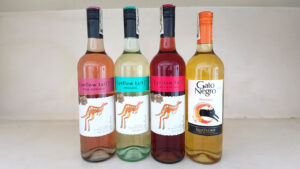Local wine trends

(Part 1)
HAPPY Year of the Wood Dragon! Entering this new lunar year, I want to share my personal thoughts on the current wine trend in our country based on my interaction, conversation, and my own experience within the wine circle.
We just concluded a relatively tough year from a wine business standpoint in 2023, but this was understandable as the wine industry was coming off a huge boom year in 2022, bolstered by the presidential election and genuine revenge spending post-COVID. Still, the outlook and potential are quite good as from the estimated imports of 12-million-liters of wine, and with our population of 110 million, the per capita wine consumption is still just a trickle, like seven tablespoonfuls. There is so much room to grow.
Moscato Wines Are Still Very PopularAustralian-produced wines are still the most popular Moscato wines sold in the country. From Yellow Tail, Gossips, to Hardys, Australian Moscato dominates the market in two of the three shades/colors: white and pink, but not red. Based on statistics from state-owned wineaustralia.com, wine exports to Philippines decreased by 7.4% in 2023 from 2022, yet Moscato as a varietal bucked this trend when it still grew by a decent 3%. The same study showed that since 2020, exports to Philippines of Moscato grew more than tenfold.
Other Moscato-producing countries include Italy (southeastern Piedmont is the origin of this varietal and is also where Philippine’s most popular sweet sparkling wine, Asti Spumante, comes from), then there is Chile and the US.
Prior to the Australian domination of Moscato, it was no more than just an ordinary varietal, and was not mentioned in the same commercial sphere as a Cabernet Sauvignon, Merlot, Chardonnay, or even Sauvignon Blanc. This varietal was available to us locally though, thanks to the top-selling market leader, the US brand Carlo Rossi, which started selling their Red Muscat back in the early 2000s. Carlo Rossi re-labelled Red Muscat as Red Moscato (it is the same varietal) to capitalize on the “Moscato” craze.
But now Moscato — the original white version — is fast catching up to Chardonnay as the most popular white varietal in the country, while the pink counterpart has bested California-created White Zinfandel as most popular pink or rosé varietal in the Philippines. I believe this trend will continue as Filipinos just have a sweet- tooth and I don’t really see this waning in the coming years.
Trading Up With Californian WinesAmerican wines, primarily from California, still dominate the Philippine wine market with over one-third of total wine imports to the country. Carlo Rossi, the omnipresent Californian wine brand from the largest private winery in the world, E&J Gallo, solidly dominates the market, mainly with their generic California Red and California White variants.
In the past, Californian wines were too polarized — they were either the entry-level generic wines, which included the likes of Carlo Rossi, Almaden, Franzia, Paul Mason (rebranded as Paul Madison recently), or the premium American Viticultural Area (AVA) or appellation-labeled Napa and Sonoma wines that included illustrious names like Opus One, Robert Mondavi, Beringer, Silver Oak, Stag’s Leap, Caymus, Ferrari-Carano, Kendall Jackson, and Simi among many. The huge gap in between the cheap generic and the expensive AVA wines is where the Australian and Chilean wines thrive in the local market.
To go from the generic California wine to a basic AVA Napa wine — “basic” as in not even like a more specific Oakville Napa AVA — is easily six to eight times more expensive. But over the past few years, I have been seeing more brands competing in the mid-price segment, led by huge Californian wineries: Barefoot (also owned by E&J Gallo); Beringer, with their Main & Vine range; and old-reliable Robert Mondavi, with their Woodbridge range.
I think this has been a long time coming, as wine in the Philippines is not cheap anymore. I remembered when wine prices were below P200 some 10 to 15 years back. Now wines are definitely considered a luxury, especially compared to other alcohol beverages where locally manufactured products enjoy so much cost-advantage. From beer, gin, rum, whisky to brandy, wine cannot compete in price. Even locally produced Novellino is priced high already given that Novellino must source their wine juice from abroad too. With a weak peso, higher freight cost, and the annual excise tax increasing, even the cheapest wines are no longer cheap and are retailing at above P300 a bottle — for context, this is roughly the same price as the popular imported Alfonso Light Brandy.
This is why I think the shift is happening, especially with California wines. A California generic, non-varietal wine is at price parity with a Chilean wine that has Cabernet Sauvignon, Merlot, or another varietal in its label. Why go generic when you can have a varietal wine?! So, with American wines being the top country of choice for Filipino consumers, I finally see this natural trading up happening, and even if California varietal wines are more expensive than their Chilean counterparts, our country’s fascination with everything American-made will help it cover for the price gap.
(If you have other observations on wine trends locally, please share them with me. I would love to hear your comments.)
(To be continued)
Sherwin Lao is the first Filipino wine writer member of both the Bordeaux based Federation Internationale des Journalists et Ecrivains du Vin et des Spiritueux (FIJEV) and the UK-based Circle of Wine Writers (CWW). For comments, inquiries, wine event coverage, wine consultancy, and other wine related concerns, e-mail the author at wineprotege@gmail.com, or check his wine training website https://thewinetrainingcamp.wordpress.com/services




